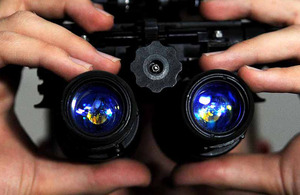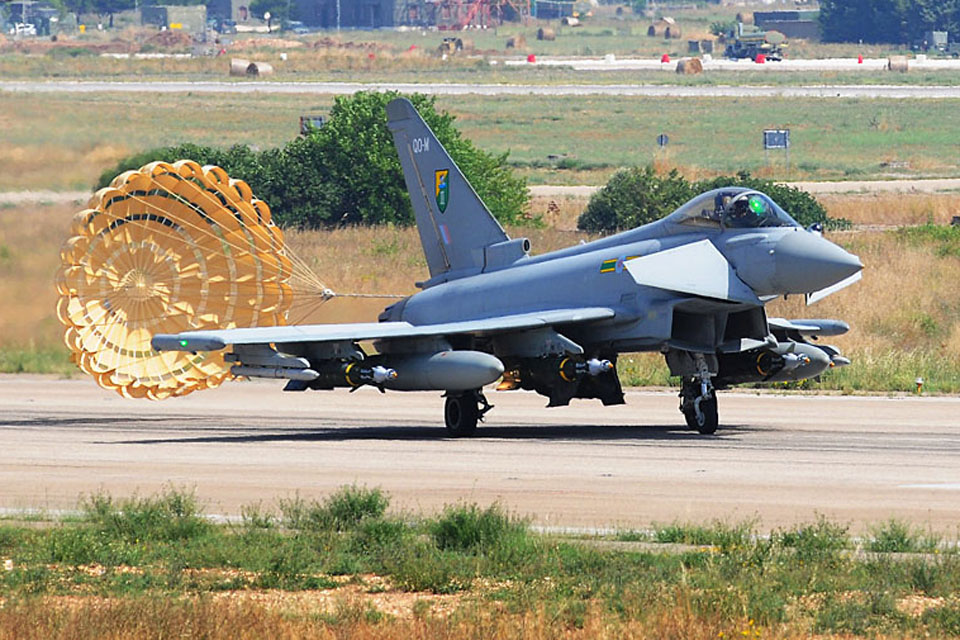'Squippers' packing a punch on Op ELLAMY
Behind the scenes on Operation ELLAMY a small team of 'squippers' or, more correctly termed, Survival Equipment Fitters, work around the clock to ensure all the aircraft survival equipment is fit for purpose.

An RAF Survival Equipment Fitter at work [Picture: Senior Aircraftwoman Tracey Dobson, Crown Copyright/MOD 2011]
This may sound a simple task, but a huge amount of work and responsibility is involved in a job that can ultimately save lives.
Corporal ‘Gaz’ Hastie has been a ‘squipper’ for 13 years, and he knows the trade better than most. He described the amount of survival equipment they have to deal with on a daily basis:
The kit we are responsible for consists of all the flying equipment; flying suits, personal survival packs, ejection seat parachutes, anti-G [Force] pants, combat survival waistcoats, life jackets, personal radio communicators (PRCs), two different types of helmet, one for day-flying and the other for night-flying, oxygen masks and the night-vision goggles.
The PRCs are essential to the aircrew; if they have to eject they can text from them and communicate securely. They also have GPS waypoints which would allow the Search and Rescue teams to locate them.

An RAF Typhoon from 3 (Fighter) Squadron with its brake chute deployed at Gioia del Colle air base in southern Italy [Picture: Senior Aircraftwoman Sally Raimondo, Crown Copyright/MOD 2011]
Since NATO launched Operation UNIFIED PROTECTOR, aimed at protecting the civilian population of Libya from attack by the Gaddafi regime, the RAF has been operating Typhoon and Tornado fast jets from Gioia del Colle air base in southern Italy, and the ‘squippers’ have been there from the start. Not only have they been servicing all the essential survival equipment and flying clothing, but they have also been repacking the Typhoons’ brake parachutes.
Before the Typhoons left theatre last month, they would occasionally deploy their brake parachutes to bring them to a halt on the runway. With a touchdown speed of approximately 140 knots (260km/h) and a weight of around 20 tonnes when full of fuel and stores, bringing a Typhoon to a halt on the runway can put a lot of strain on the aircraft’s braking system. More wear means shorter service life for the affected components.
It is not standard practice, but if the aircraft land heavy with munitions and fuel, streaming the parachute is useful to shorten the ground run and reduce ‘wear and tear’ on the brakes.
But what happens to the parachute after deployment once the aircraft has come to a halt?
Enter the ‘squipper’, whose job it is to repack the parachute ready for its next mission.
First task for the ‘squipper’ is to check the chute for damage, particularly important because it has been deployed at speed, and subjected to enormous forces before being dragged, unceremoniously, along a tarmac runway:
Here at Gioia, we get all sorts of stuff caught up in the chute, from vegetation to bits of gravel, and even insects, lizards and snails,” says Corporal Sarah Griffiths, a ‘squipper’ for the Typhoon squadrons. “Our first job is to untangle everything, check for damage and remove any debris.
Once untangled, the parachute has to be carefully refolded in a precise pattern to ensure that it will deploy correctly the next time. It then has to be repacked into a protective sleeve which at first glance appears much too small to accommodate the entire parachute.
Repacking the chute is hard, physical work and, once repacked, the ‘squippers’ must carefully sew the sleeve using a needle and red thread. The breaking strain of the sewn seal must also be precisely calculated allowing the package to break instantly on deployment.
And that’s just one of their many, vital tasks. Both the Typhoon and Tornado Forces have been clocking up thousands of flying hours and hundreds of sorties, and every time the aircraft prepare for a sortie the ‘squippers’ are there to see the aircrew off, referred to as a ‘see off’:
We’ll sit with them [the aircrew] until they’ve done all their checks and they’re happy that everything’s working as it should be. If they have any problems with the kit we take spares down or try and fix it there and then. Sometimes you can be down there anywhere between one to three hours,” says Corporal Hastie.
Senior Aircraftman Gary Thomson has only been out of training for a year and this is his first deployment; he says, at times, it can be daunting:
The first few times going down ‘the line’ [the aircraft pan] on your own is quite nerve-racking; there’s a lot of pressure because they need to get out flying and they’re looking at you to get their kit right or fix it there and then on the spot. Plus, it’s really noisy with all the jets going so it’s quite difficult to hear anything, and you’ve got the engineers and the aircrew waiting on you to get things sorted.
But by the time I got out here I had so much training and experience on ‘the line’ at RAF Marham that it wasn’t too bad, you get to know the kit really well.